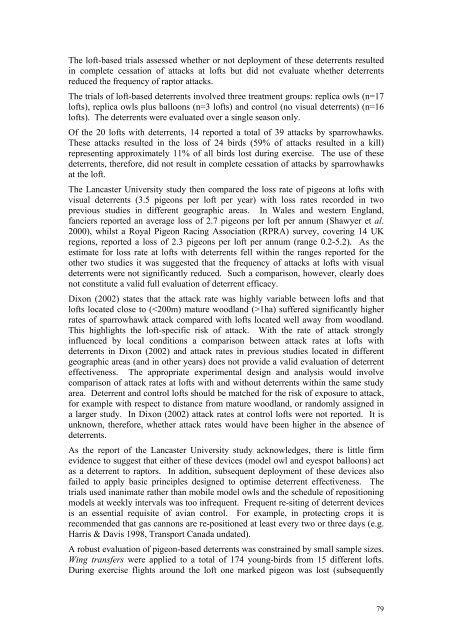RACING PIGEONS â IMPACT OF RAPTOR PREDATION
RACING PIGEONS â IMPACT OF RAPTOR PREDATION
RACING PIGEONS â IMPACT OF RAPTOR PREDATION
You also want an ePaper? Increase the reach of your titles
YUMPU automatically turns print PDFs into web optimized ePapers that Google loves.
The loft-based trials assessed whether or not deployment of these deterrents resulted<br />
in complete cessation of attacks at lofts but did not evaluate whether deterrents<br />
reduced the frequency of raptor attacks.<br />
The trials of loft-based deterrents involved three treatment groups: replica owls (n=17<br />
lofts), replica owls plus balloons (n=3 lofts) and control (no visual deterrents) (n=16<br />
lofts). The deterrents were evaluated over a single season only.<br />
Of the 20 lofts with deterrents, 14 reported a total of 39 attacks by sparrowhawks.<br />
These attacks resulted in the loss of 24 birds (59% of attacks resulted in a kill)<br />
representing approximately 11% of all birds lost during exercise. The use of these<br />
deterrents, therefore, did not result in complete cessation of attacks by sparrowhawks<br />
at the loft.<br />
The Lancaster University study then compared the loss rate of pigeons at lofts with<br />
visual deterrents (3.5 pigeons per loft per year) with loss rates recorded in two<br />
previous studies in different geographic areas. In Wales and western England,<br />
fanciers reported an average loss of 2.7 pigeons per loft per annum (Shawyer et al.<br />
2000), whilst a Royal Pigeon Racing Association (RPRA) survey, covering 14 UK<br />
regions, reported a loss of 2.3 pigeons per loft per annum (range 0.2-5.2). As the<br />
estimate for loss rate at lofts with deterrents fell within the ranges reported for the<br />
other two studies it was suggested that the frequency of attacks at lofts with visual<br />
deterrents were not significantly reduced. Such a comparison, however, clearly does<br />
not constitute a valid full evaluation of deterrent efficacy.<br />
Dixon (2002) states that the attack rate was highly variable between lofts and that<br />
lofts located close to (1ha) suffered significantly higher<br />
rates of sparrowhawk attack compared with lofts located well away from woodland.<br />
This highlights the loft-specific risk of attack. With the rate of attack strongly<br />
influenced by local conditions a comparison between attack rates at lofts with<br />
deterrents in Dixon (2002) and attack rates in previous studies located in different<br />
geographic areas (and in other years) does not provide a valid evaluation of deterrent<br />
effectiveness. The appropriate experimental design and analysis would involve<br />
comparison of attack rates at lofts with and without deterrents within the same study<br />
area. Deterrent and control lofts should be matched for the risk of exposure to attack,<br />
for example with respect to distance from mature woodland, or randomly assigned in<br />
a larger study. In Dixon (2002) attack rates at control lofts were not reported. It is<br />
unknown, therefore, whether attack rates would have been higher in the absence of<br />
deterrents.<br />
As the report of the Lancaster University study acknowledges, there is little firm<br />
evidence to suggest that either of these devices (model owl and eyespot balloons) act<br />
as a deterrent to raptors. In addition, subsequent deployment of these devices also<br />
failed to apply basic principles designed to optimise deterrent effectiveness. The<br />
trials used inanimate rather than mobile model owls and the schedule of repositioning<br />
models at weekly intervals was too infrequent. Frequent re-siting of deterrent devices<br />
is an essential requisite of avian control. For example, in protecting crops it is<br />
recommended that gas cannons are re-positioned at least every two or three days (e.g.<br />
Harris & Davis 1998, Transport Canada undated).<br />
A robust evaluation of pigeon-based deterrents was constrained by small sample sizes.<br />
Wing transfers were applied to a total of 174 young-birds from 15 different lofts.<br />
During exercise flights around the loft one marked pigeon was lost (subsequently<br />
79
















